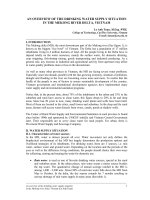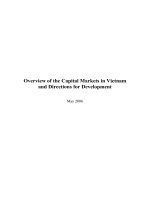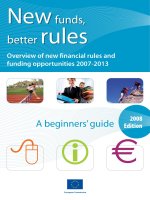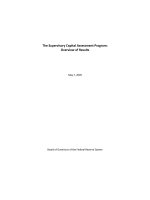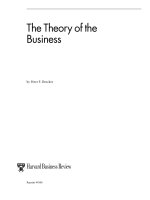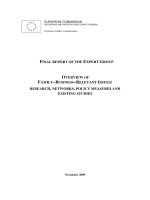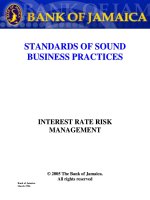OVERVIEW OF FAMILY–BUSINESS–RELEVANT ISSUES: RESEARCH, NETWORKS, POLICY MEASURES AND EXISTING STUDIES pdf
Bạn đang xem bản rút gọn của tài liệu. Xem và tải ngay bản đầy đủ của tài liệu tại đây (214.09 KB, 33 trang )
EUROPEAN COMMISSION
ENTERPRISE AND INDUSTRY DIRECTORATE-GENERAL
Promotion of SMEs’ competitiveness
F
INAL REPORT OF THE EXPERT GROUP
OVERVIEW OF
FAMILY–BUSINESS–RELEVANT ISSUES:
RESEARCH, NETWORKS, POLICY MEASURES AND
EXISTING STUDIES
November 2009
2
Legal Notice
This project was carried out by the European Commission and experts in the field of
family business appointed by the national authorities, under the Multiannual
Programme for Enterprise and Entrepreneurship coordinated by the European
Commission’s Directorate-General for Enterprise and Industry.
Although the work was carried out under the guidance of Commission officials and by
experts appointed by the national governments, the views expressed in this document do
not necessarily represent the opinion of the European Commission or the participating
countries.
Reproduction is authorised, provided the source is acknowledged.
Further information:
European Commission
Directorate-General for Enterprise and Industry
Unit E.3: Crafts, small businesses, cooperatives and mutuals
Fax: +32-2-299.81.10
E-mail:
Information on other projects:
Information on other projects jointly carried out by the European Commission and by
national administrations that address issues of promoting the competitiveness or
European SMEs can be found on the web, at the following address:
/>
3
TABLE OF CONTENTS
EXECUTIVE SUMMARY 4
1. INTRODUCTION 6
1.1. Aim of the project and method 6
1.2. Result of the project and sources of information 6
2. DEFINING A ‘FAMILY BUSINESS’ 8
2.1. Characterising ‘family businesses’ 8
2.2. A European definition of a ‘Family Business’ 9
3. CHALLENGES 11
3.1. Unawareness of policy makers of the specificities of family businesses and their
economic and social contribution 12
3.2. Financial issues 13
3.3. The importance of preparing business transfers early 15
3.4. Balancing family, ownership, and business aspects: Family Governance 16
3.5. Attracting and retaining a (skilled) workforce 17
3.6. Entrepreneurship education and family-business-specific management training 18
4. THE COMMISSION’S WORK 19
5. GOOD PRACTICES 21
6. CONCLUSIONS AND STRATEGIC RECOMMENDATIONS 22
Annex I — Good Practices 25
Annex II — Members of the Expert Group 28
Annex III — Bibliography 32
4
EXECUTIVE SUMMARY
Family firms are important, not only because they make an essential contribution
to the economy, but also because of the long-term stability they bring, the specific
commitment they show to local communities, the responsibility they feel as owners
and the values they stand for. These are precious factors against the backdrop of the
current financial crisis.
Family businesses make up more than 60
% of all European companies,
encompassing a vast range of firms of different sizes and from different sectors.
Most SMEs (especially micro and small enterprises) are family businesses and a
large majority of family companies are SMEs.
It is essential to agree on an accepted definition of what is a family business to
have a better view. There is general agreement on three essential elements: the
family, the business, and ownership. After having analysed existing definitions, the
expert group proposes the following definition:
A firm, of any size, is a family business, if:
1) The majority of decision-making rights is in the possession of the natural
person(s) who established the firm, or in the possession of the natural
person(s) who has/have acquired the share capital of the firm, or in the
possession of their spouses, parents, child or children’s direct heirs.
2) The majority of decision-making rights are indirect or direct.
3) At least one representative of the family or kin is formally involved in the
governance of the firm.
4) Listed companies meet the definition of family enterprise if the person who
established or acquired the firm (share capital) or their families or
descendants possess 25 per cent of the decision-making rights mandated by
their share capital.
The group recommends exploring opportunities to introduce this definition at
national level. The European Commission should envisage using this definition
where possible to help promote its use.
The notion of ownership is fundamental to family businesses. It is important to
improve our knowledge of ownership and how it affects the business behaviour of
family firms.
Many of the challenges faced by family businesses also concern SMEs in general.
However, some affect family firms more specifically, and others are exclusive to
them. Some challenges stem from the environment in which companies operate,
e.g. policy makers are unaware of the specificities of family businesses and their
economic and social contribution; financial issues related to gift and inheritance
tax, access to finance without losing control of the firm, favourable tax treatment of
reinvested profits. Some are related to the family firm’s internal matters e.g.
5
unawareness of the importance of planning company transfers early; balancing the
family, ownership and business aspects within the enterprise; difficulties in
attracting and retaining a skilled workforce. Other issues regarding education and
research impact on both the environment and internal matters, e.g. (lack of)
entrepreneurship education and family-business-specific management training, and
the need for more research into family-business-specific issues.
The institutional framework and policy initiatives regarding family businesses
differ from country to country. Measures favouring family businesses are (or have
been) implemented by different actors and tackle a range of problems, e.g. taxation,
company law, planning the business transfer, awareness-raising through lobbying
and policy advice, research and dissemination of information, promotion of
entrepreneurship and family-business-specific education, and family governance.
Exchanging the ‘good practices’ identified has great potential for development of
the sector. The European Commission should continue to play a role in promoting
the exchange of information. Family businesses already benefit from EU policies.
The European Commission should continue mainstreaming family-business-
relevant issues in all relevant schemes.
National governments should consider adopting measures to create a more
favourable environment for family businesses, for example in areas of taxation,
company law, and the educational system. The group also recommends setting up a
specific family business contact point in national administrations.
Family businesses themselves and especially organisations representing the family
business sector (at national and international levels) should take an active role in all
efforts to raise awareness of the importance of the sector. They should also promote
the development of a family business institutional framework in countries in which
it is less developed.
6
1. INTRODUCTION
1.1. Aim of the project and method
For the purpose of getting a more comprehensive overview of family
businesses in Europe, their characteristics, specific needs, the institutional
framework and initiatives already implemented in their favour, in 2007 the
European Commission launched the project ‘Overview of family-business-
relevant issues: research, networks, policy measures and recent studies’.
This was funded by the Competitiveness and Innovation Framework
Programme 2007-2013 (CIP).
The project used the open method of coordination in the field of enterprise
policy, which aims to focus political attention on key issues, agreed with
national experts and in consultation with business organisations, to promote
the exchange of experiences which may give rise to policy changes to
improve the business environment.
The information obtained should also serve as a basis for analysing the need
for future policy initiatives at European level in favour of family business, of
which small and medium sized businesses have hitherto been included in the
Commission’s overall SME policy.
1.2. Result of the project and sources of information
This report sets out the main results of the project and is based on two main
sources of information: the discussions of the Expert Group on Family
Business (hereinafter referred to as ‘the expert group’, ‘the experts’, or ‘the
group’), and the study entitled ‘Overview of family-business-relevant issues’
(hereinafter referred to as ‘the study’). The report is the result of cooperation
between the Commission and members of the expert group.
The expert group began its work in 2007. Its members were appointed by the
Member States and other countries participating in the Competitiveness and
Innovation Framework Programme. Some experts in the field were also
appointed by the European Commission. The group met five times between
May 2007 and October 2009 to discuss the main problems faced by family-
run businesses. It also identified existing research, good practices and family
business organisations (networks).
The experts also oversaw the production of the study, which was
commissioned to KMU Forschung Austria in 2007 through an open call for
tenders. Research was carried out in 2008.
The study was completed and published in January 2009. 33 countries were
covered: the EU27 Member States, other EEA countries (Liechtenstein,
7
Norway and Iceland) and the candidate countries (Turkey, Croatia and
Macedonia). The study provides an overall description of family businesses at
European level and more detailed information on each of the countries
covered. It identifies a set of good practices and a database of family-
business-related organisations. All these documents are available on the
family business webpage of DG Enterprise & Industry.
1
It is important to point out that the study was carried out before the financial
crisis broke out, and therefore the outcome does not describe its impact on
family firms, or their special position in the context of the crisis (compared to
non-family-run firms).
The identity of a family business hinges on its ownership. Most SMEs
(especially micro and small enterprises) are family businesses and a large
majority of family companies are SMEs. Although the project does not
exclude large family firms, it focuses on family business that are also SMEs.
2
References to other literature consulted are given throughout this report.
1
/>business/index_en.htm.
2
SMEs are defined in Commission Recommendation of 6 May 2003 concerning the definition of
micro, small and medium-sized enterprises (Official Journal of the European Union L124/36,
20.5.2003). Further information at:
/>.
8
2. DEFINING A ‘FAMILY BUSINESS’
One of the objectives of the project was to gain an overview of how family
businesses are defined in the different countries surveyed. To avoid limiting or
influencing the outlook of the research, no strict definition of a ‘family business’
was established beforehand. The work was guided by the general notion of
‘businesses in which a family has influence’.
2.1. Characterising ‘family businesses’
Family businesses cover a vast range of firms in different sectors and of
different sizes. They range from sole proprietors to large international
enterprises and make up more than 60
% of all European companies.
3
Specialised literature clearly shows that ‘there is not a single definition of
‘family business’ which is exclusively applied to every conceivable area, such
as to public and policy discussions, to legal regulations, as an eligibility
criterion for support services, and to the provision of statistical data and
academic research’.
4
It suggests that, although the debate on
this topic is far from exhausted, there is
general agreement that a definition of
family business has to incorporate three
essential elements: the family, the
business and ownership. This was first
illustrated by the ‘3-circle’ model of
family business developed by Tagiuri &
Davis in 1982. The experts support the
use of the 3-circle approach when
studying the phenomenon of family
businesses.
Ownership is key to the business life of the firm. It enables a clear distinction
to be made between family and non-family businesses. Taking the ‘ownership
perspective’ rather than the ‘company size’ perspective can help improve
understanding of the phenomenon.
Related to this is the focus placed on the quality of assets in their balance
sheets, i.e. family business financial management focuses on the balance
sheet rather than the profit and loss account.
3
Figures may vary among studies (even in the same country) since they depend on the definition used.
4
KMU Forschung Austria, ‘Overview of family business relevant issues’, Vienna, 2008 (p. 1).
Ownership
Business
Famil
y
Tagiuri & Davis, 1982.
“3-Circle” model of family business
9
The study identified more than 90 definitions, which shows that even within
the same country several different definitions can be used. They take into
account many aspects, such as family ownership, involvement of the
management, strategic control, business as the main source of income for the
family and intergenerational transfers.
One common feature to almost all definitions is that they are not operational,
which to a large extent limits their usefulness, particularly for the production
of reliable and comparable statistics on the sector.
In addition, as Astrachan, Klein and Smyrnios have pointed out, ‘a definition
of family is often missing’ and ‘this notable absence poses problems,
particularly in an international context where families and cultures differ not
only across geographical boundaries, but also over time.’
5
Some definitions do not consider the status of being a ‘family business’ as
static, but accept that it may drift between a family firm and a non-family
firm.
The study shows that the self-employed/one-person enterprises are
considered family businesses in approximately one third of the countries
surveyed. Sole proprietors (i.e. companies with one owner but that may
employ other family and/or non family members) are considered to be family
firms in most countries.
2.2. A European definition of a ‘Family Business’
The difficulties in reaching a commonly agreed definition are well
documented and recognised by the group.
In order to be useful, the definition must be simple, clear and easily
applicable. It should enable statistics to be produced on the sector (e.g.
contribution of family businesses to employment, total turnover of family
businesses) and should be comparable between countries.
The definition proposed in this report is based on the one formulated by the
Finnish Working Group on Family Entrepreneurship (set up by the Ministry
of Trade and Industry of Finland in 2006). The Finnish definition has been
widely accepted and has the advantage of being comprehensive and
operational.
6
5
ASTRACHAN, J. — KLEIN, S. — SMYRNIOS, K. ‘The F-PEC scale of family influence: a
proposal to solving the family business definition problem’, in Handbook of Research on Family
Business, Edward Elgar, UK, 2006 (p. 167).
6
The definition used by the Finnish Ministry of Trade and Industry is given on page 98 of the study.
10
With the aim of making it clearer and applicable to all types of enterprises
(particularly vis-à-vis SMEs), some slight modifications to the terminology
were made.
7
The proposed definition reads as follows:
A firm, of any size, is a family business, if:
(1) The majority of decision-making rights is in the possession of the
natural person(s) who established the firm, or in the possession of the
natural person(s) who has/have acquired the share capital of the firm,
or in the possession of their spouses, parents, child or children’s
direct heirs.
(2) The majority of decision-making rights are indirect or direct.
(3) At least one representative of the family or kin is formally involved in
the governance of the firm.
(4) Listed companies meet the definition of family enterprise if the person
who established or acquired the firm (share capital) or their families
or descendants possess 25 per cent of the decision-making rights
mandated by their share capital.
This definition includes family firms which have not yet gone through the
first generational transfer. It also covers sole proprietors and the self-
employed (providing there is a legal entity which can be transferred).
This definition represents the opinion and agreement of the members of the
expert group. The group recommends using it in the Member States and other
countries covered by the project to produce quantitative (and comparable at
European level) information on the family business sector.
7
For example, the term ‘votes’ was replaced by ‘decision-making rights’, ‘management and
administration’ was replaced by ‘governance’, and it was also specified that at least one representative
of the family or kin is ‘formally’ involved in the governance of the firm.
11
3. CHALLENGES
The project also aims to analyse whether family businesses face specific challenges
that hamper their growth and development.
The challenges family businesses face can be grouped into three different
categories: those common to any type of business (family businesses and non-
family businesses), those that affect all businesses but are of particular concern to
family businesses and challenges that only family firms face. The study focused on
the last two categories of challenges.
The challenges can also be categorised according to their origin.
Taking these approaches, the following list of challenges was drawn up:
• Challenges that arise from the environment in which companies operate:
◦ Unawareness of policy makers of the specificities of family businesses,
and their economic and social contribution;
◦ Financial issues (e.g. gift and inheritance tax, access to finance without
losing control of the firm, favourable tax treatment of reinvested
profits).
• Challenges that develop as a consequence of the family firm’s internal
matters:
◦ Unawareness by family firms of the importance of planning business
transfers early;
◦ Balance between the family, ownership and business aspects within the
enterprise;
◦ Difficulties in attracting and retaining a skilled workforce.
• Challenges related to educational aspects, which have an impact on both the
business environment and on family firms’ internal matters:
◦ Lack of entrepreneurship education and family-business-specific
management training and research into family-business-specific topics,
plus effective coordination with education systems to ensure proper
follow-up.
Policies favouring family businesses predominantly focus on the first group
(environment) and the third group (educational aspects). They can also help
overcome difficulties of an ‘internal’ origin (e.g. a public campaign to make owners
aware of the importance of planning company transfers early).
12
3.1. Unawareness of policy makers of the specificities of family businesses
and their economic and social contribution
The limited awareness of policy makers of the specificities of family
businesses and the contribution they make to society is due to the
traditionally discrete behaviour of the sector. This has changed in recent years
and family businesses are increasingly trying to assert their ‘family character’
to differentiate themselves from non-family firms, to highlight their special
contribution to society and their commitment to local communities to
underline that they are responsible owners and there is a ‘human face behind
the business’. Research has also accompanied this process and since the
1980s, the number of studies and publications on family business related
topics has steadily risen.
This change has evidently been favourable for the family business sector as
there is now a general understanding that more than 60
% of all European
companies are family owned, representing between 40
% — 50
% of all jobs.
However, there is still a lack of robust data, which usually leads to inaccurate
assumptions (such as equating all family businesses with SMEs).
A commonly recognised definition of family businesses would significantly
help overcome this challenge. The availability of reliable information is
essential to make policy makers (at all levels) aware of the importance of the
family business sector, and to advocate favourable action.
The lack of awareness of the family business sector is not limited to policy
makers. Even though the notion of ‘family business’ seems well known and
recognised by the general public, a clear and precise picture of the real
contribution that family businesses make to society is lacking.
Therefore, the importance of having a ‘family business contact point’ in the
European Commission and at national governments is highlighted.
There is also a need for more applied research, which could be useful for
decision makers. Although research has increased in recent years, more work
should be focused on getting results with a cross-national approach and to
quantitatively measure the scale of the phenomenon from the point of view of
its economic and social importance. Other fields for research are innovation
in family firms, the performance of family businesses, ownership and mergers
in family enterprises.
National representative organisations promote better dialogue between the
family business sector and the government and help convey the concerns
faced by the sector into policy consultation processes.
Many different steps can be taken to overcome the challenge of awareness,
and they can involve different actors. However, organisations representing
the family business sector have an important role to play by stepping up
contacts with policy makers and disseminating information to them and to the
13
public. Cross-border family business organisations could, for example,
encourage exchanges between countries with a long experience in the field
(i.e. with a more developed institutional and political framework), and those
in which the phenomenon is more recent.
Introducing a common EU definition of a family business and implementing
it by national statistical offices (and ultimately by EUROSTAT) would
facilitate better and clearer understanding. As set out in Section 2 of this
report, the European Commission took the first step towards this by setting up
the expert group.
National governments should take account of the views of the family business
sector in relevant policies (e.g. by involving them in existing consultation
mechanisms).
At European level, this is already done. Impact assessments and consultations
on policy measures are open to the public and to all stakeholders.
3.2. Financial issues
Family businesses face the same financial constraints as any other type of
business and also face certain specific challenges related to succession
(transfer of the company within the family) and to the choice of financing
method (equity vs. debt financing, reinvestment of profits). In all cases, the
issue of taxation plays a major role.
a) Fiscal bias on equity finance rather than debt finance
As set out in the study, the transfer of a family firm triggers a series of
financial constraints which may endanger the viability of the business. The
payment of inheritance and/or gift tax represents the biggest challenge. Tax
systems are typically set up to counteract wealth accumulation and as a result
may put financial pressure on the family company, which can destabilise its
capital base.
Moreover, the intergenerational transfer process may require funds to, for
example, buy the shares of heirs not willing to be involved in the business.
The situation varies enormously between the countries surveyed. The study
gives examples of the different regulations implemented in Europe to
illustrate this diversity.
b) Financial disadvantages of equity financing (compared to debt financing)
One of the characteristics of family businesses is their long-term
sustainability, often associated with cautious risk-taking behaviour. This has
an impact on the financial decisions they take.
14
Owner-managers of privately held family firms tend to be reluctant to take in
external investors. They have a preference for financial instruments that do
not erode their control. While most family firms have limited access to capital
markets, it is in their nature to build a capital base by retaining earnings.
Family firms play a significant role in investment. They finance their capital
needs, primarily using internally available funds or family funds, followed by
debt, and consider using external equity as a last resort.
The Summary Report of the Expert Group ‘Effects of tax systems on the
retention of earnings and the increase of own equity’, indicates that
strengthening the equity base of companies through the retention of earnings
is, to some extent, related to taxation.
In many countries, taxation systems discriminate in favour of debt financing
(i.e. corporate tax systems allow the deduction of interest from debt, but do
not take into account the cost of capital in the form of equity financing). This
‘interest tax shield’ encourages debt financing since it lowers the relative cost
of debt. Discrimination against retained earnings is seen as an obstacle to
making balance sheets stronger, which not only hinders growth, but also
access to cheaper debt finance.
8
Reinvestment of profits plays an important role in the capitalisation of family
firms. The debt-equity ratio of family companies is often lower than non-
family firms. A lower debt-equity ratio makes undertakings less vulnerable
during recessions and also alleviates the problems of structural changes and
re-focusing the business.
In countries where the taxation system favours debt financing, family
companies are at a disadvantage.
This may be compounded in the current climate. Recent research suggests
that tax systems probably contributed to the financial crisis by encouraging
companies to take on excessive debt.
9
Taxation is a competence of the Member States, and therefore any changes to
the tax systems (e.g. reducing inheritance and/or gift tax, more favourable tax
regimes for retained profits) must be made at national level. However, the EU
can play a role in collecting and disseminating good practices in this field. A
concrete example of this was the work carried out by the expert group
8
Summary Report of the Expert Group ‘Effects of tax systems on the retention of earnings and the
increase of own equity’, Brussels, September 2008 (p. 35).
9
IMF (Fiscal Affairs Department), ‘Debt bias and other distortions: crisis-related issues in tax policy’,
June 2009.
15
‘Effects of tax systems on the retention of earnings and the increase of own
equity’.
10
National governments may also consider issuing regulations to grant access
to finance to family enterprises, without threatening decision-making powers
within the company (e.g. by allowing non-vote stocks).
3.3. The importance of preparing business transfers early
Succession is seen by many authors as the most important issue that family
businesses have to cope with. It is also widely agreed that intergenerational
transfer is not a single event, but a process that needs to be planned in
advance in order to succeed.
11
This ‘process approach’ is fully supported by
the members of the expert group.
The diversity of family businesses also affects intergenerational transfers.
The issue differs according to size of the company, the size of the family
and/or age of the company. The problem is not the same for a large company
managed/owned by the third generation of a family and a small company with
only one owner (who may be also its founder).
One specific aspect of transferring family businesses is the transfer of
ownership. Ownership has a special meaning in family firms. It also involves
a strong ‘personal’ factor. When a business is transferred within the family,
the financial capital is transferred with a ‘social and cultural capital’
12
that
usually leads to an enhanced personal commitment to the company and to the
community. Family owners don’t think they own simply capital; ownership
also encompasses persons, products, responsibilities, etc. Ownership of a
family business is not seen as a liquid asset but as a property which is built
and developed by the family over generations.
Moreover, the whole process of transferring the business is even more
important for family companies because, alongside the transfer of ownership,
the knowledge accumulated from generation to generation is at stake. Both
the person leaving the business and the entrepreneur taking over should be
convincingly involved. In family firms, emotional aspects attached to the
10
11
MAZZOLA, P. — MARCHISIO G. — ASTRACHAN J., ‘Using the strategic planning process as a
next-generation training tool in family business’, in Handbook of Research on Family Business,
Edward Elgar, UK, 2006 (p. 403).
12
KARLSSON STIDER (2000). ‘Familjen & Firman’. EFI: Stockholm
ASTRACHAN, Joe and KARSLON STIDER, Annelie (2004): ‘Family relations’. In WARD, J. and
KENYON ROUVIEZ, D., ‘Family business: key issues’, Palgrave Macmillan (2005).
16
transfer need to be carefully managed since the leaver may continue to
influence the business even after the transfer has taken place.
The main issue to tackle to successfully complete the transfer is to raise
awareness of the importance of early preparation, and to make available tools
for the transfer (e.g. specialised training for the parties involved).
This type of initiative is best undertaken at local level, or by private-sector
organisations.
Some countries already implement innovative and effective measures, and
these positive experiences should be shared. The study identified many such
measures (more information in Section 5 of this report, in Annex IV to the
study and in the database of family-business-related organisations).
3.4. Balancing family, ownership, and business aspects: Family Governance
The overlap between the family, the business and ownership is not always
well balanced. Divergences between the multitude of players and interests
involved may cause conflicts, and may even endanger the existence of the
company. The risks heighten as intergenerational transfers take place and the
complexity of the family involved in the business grows.
In addition to usual business management skills, the particular composition of
family firms requires a special type of management, often referred to as
‘family governance’, which seeks to minimise potential tensions, particularly
within the family and between the family and the business aspects.
Many researchers, and the expert group, are of the opinion that the process
families go through to prepare, for example, a family protocol, is more
important than the outcome itself. It is during this process that family
businesses need to ‘make an effort to identify and make explicit and
transferable to the subsequent generation and to other stakeholders the main
reasons for its own commitment to the business; the philosophy that inspires
the family in its relationship with, and control of, the business (…); the goals
pursued by the family and the business, and the rules that govern the
relationship between the family and the business.’
13
The study showed that family governance has been extensively developed in
some countries, but very little in others. There is a wide range of tools already
available or being implemented. They range, for example, from the provision
of subsidies to companies to cover the cost of specialised consulting services
13
GALLO M. — TOMASELLI S., ‘Formulating, implementing and maintaining family protocols’, in
Handbook of Research on Family Business, Edward Elgar, UK, 2006 (p. 298).
17
to prepare a family protocol, to freely available guidelines providing standard
texts and solutions for families to overcome their specific problems.
However, the study also showed a lack of awareness within family businesses
of the importance of this issue, and of the tools currently available.
More efforts need to be made to disseminate information on family
governance tools to take full advantage of this diversity.
The European Commission has started to promote such exchanges by
discussing different experiences within the expert group, and more
significantly, by gathering information on existing measures in the countries
studied.
National governments and private-sector organisations should make the most
of this information to find examples suitable for implementation in their
countries.
3.5. Attracting and retaining a (skilled) workforce
The negative image of family businesses in the labour market is also
considered one of the biggest challenges that family firms face.
Although being a family firm may be an advantage in the company’s relations
with its clients or partners, in many countries there is an overall negative
perception of professional ‘career progression’ in family businesses, which
makes them less attractive in the labour market (particularly for more skilled
people).
Sometimes family business are perceived as organisations in which nepotistic
and paternalistic practices are rife, and in which a non-family member will
always be at a disadvantage compared to a family member (even if the latter
is less prepared for the job).
This unattractive image in the labour markets seems to be worse for small
companies. The general problems smaller enterprises face (e.g. lower wages,
limited career opportunities, out-of-date procedures) are compounded by
those linked to it being a family firm, exacerbating the situation.
Changing the rather negative and unattractive image of family businesses in
the labour market is mainly down to the sector itself. Where perceptions
reflect the reality, the main focus of family businesses’ efforts should be to
change unfavourable practices (e.g. by professionalising the management of
family firms).
For family firms that do not correspond to this negative perception, more
focus should be placed on improving communication of the real potential that
the company represents for people in the labour market.
18
Campaigns to improve the image of family businesses in the labour market
should target all types of workforce (lower and higher-level positions).
Outside of the company itself, (i.e. the external environment), the group also
recommends paying attention to the ‘narrative’ taught in schools, which can
certainly contribute, in a positive or a negative way, to the image people
develop of an entrepreneur or of a family business as a potential employer.
A positive image of family businesses may encourage people to consider
becoming an entrepreneur themselves.
Organisations representing the family business sector should take the lead in
improving the image of family businesses in society, and make them more
attractive in the labour market.
3.6. Entrepreneurship education and family-business-specific management
training
Entrepreneurship is hugely relevant to family businesses. Most start-ups
begin as a family business and are faced with the question as to whether they
want to continue the business beyond the founders. Therefore, promoting
entrepreneurship is directly linked to promoting family businesses.
As most start-ups begin as a family business, education should also include
specific family business issues such as ownership, succession and family
governance to better prepare future entrepreneurs to successfully run their
businesses.
Management training should not be confined to business schools. It should be
somehow included in the curricula of all professions to promote the
entrepreneurial spirit in all fields. The concept of ‘ownership education’
should be further developed.
Entrepreneurship education should aim to foster new family entrepreneurs,
but also to promote entrepreneurial behaviour (including innovation) in
existing family firms. This knowledge should enable heirs to re-invent the
business, which is proved to be what keeps the company going from each
generation.
National governments could plan to make changes to their education systems
and work closely or in partnership with private-sector organisations and
educational institutions (e.g. business schools and universities) to develop
family-business-specific courses as part of existing curricula or as new
curricula.
19
4. THE COMMISSION’S WORK
The Commission recognises the importance of family businesses. The first of the
ten principles of the Small Business Act for Europe is to ‘create an environment in
which entrepreneurs and family businesses can thrive and entrepreneurship is
rewarded’.
Family businesses benefit from all schemes run by the Commission to promote a
favourable business environment. Nevertheless, some schemes run by the
Commission under its SME policy are particularly relevant to family businesses.
14
• Transfer of businesses: the Commission’s work to encourage Member States
to facilitate transfers began in the 1990s (Commission Recommendation of
1994, Commission communication of 1998, Expert Group in 2000, Commission
communication of 2006). In addition, a pilot project of the European Parliament
on ‘Transfer of Expertise through Mentoring in SMEs’ was recently finalised.
Through this project, mentoring was provided to more than 800 entrepreneurs
involved in transferring an SME. For more information, see:
/>transfer/index_en.htm.
• Enterprise Europe Network: the network re-launched in 2008 pools more than
500 organisations providing assistance to SMEs. It has great potential to
disseminate family business relevant issues in Europe and abroad. More
information:
• The European SME Week: this Europe-wide campaign to inform
entrepreneurs of the range of support measures available to them at European
level is also a platform to promote specific family business issues throughout
Europe. During the 2009 edition, several family businesses specific events were
organised under the umbrella of the SME week. For more information, see:
• Erasmus for young entrepreneurs: the aim of this project is to help new
entrepreneurs acquire skills for managing a small or medium-sized enterprise
(SMEs) by spending time in a business in another EU country. It is a useful tool
for family businesses to learn from and exchange experiences with other EU
countries. See:
/>entrepreneurship/erasmus-entrepreneurs/index_en.htm.
• The European Conference Charter for SMEs ‘From the European Charter
for Small Enterprises to the Small Business Act’ encourages the exchange of
experience on SME policy measures. One family-business-specific best practice
14
This list is not exhaustive but provides some examples of measures implemented by the European
Commission. For more specific information on the EU’s SME policy, visit the website
20
was selected for the 2009 edition of the conference. See:
• Enterprise Awards: the aim of the awards is to identify and recognise
successful activities and initiatives undertaken to promote enterprise and
entrepreneurship, raise awareness of the role entrepreneurs play in society and
encourage and inspire potential entrepreneurs. For more information, see:
/>awards/index_en.htm.
• Expert group ‘Effects of tax systems on the retention of earnings and the
increase of own equity’: the aim of this expert group was to identify and
recognise the tax provisions and aspects which, according to business owners,
have a major impact on the decision to retain earnings. The results of the work
are relevant since the dichotomy between ‘equity financing / debt financing’ is
of great interest for the family business sector. See:
/taxation-
smes/index_en.htm.
• Lifelong Learning Programme: this programme supports transnational
education and training activities. In addition to enabling individuals to pursue
stimulating learning and training opportunities across Europe, it helps education
and training institutions and systems to modernise by funding transnational
projects. For more information, see: />learning-programme/doc78_en.htm.
21
5. GOOD PRACTICES
One of the aims of the project was to identify measures favouring family businesses
which are being or have been implemented and have proven to be successful. The
outcome of the research carried out was significant.
More than one hundred measures (implemented in the 33 countries surveyed) were
singled out. The measures identified are very diverse in the topics they tackle and
in the different actors and methods used to implement them.
Ten best practices were selected according to different criteria (e.g. geographic
representation of the different countries, type of entity implementing it, problem
addressed). They are grouped into the following categories (although some cover
more than one issue):
• taxation;
• company law;
• planning business transfers;
• lobbying — policy advice — awareness raising;
• research and dissemination of information;
• promotion of business / management-specific education;
• family governance.
The number and variety of measures in favour of the sector was higher in countries
where the family business institutional framework is more developed.
An overview of these groups of measures is given in Annex I to this report. A
detailed description of the ten best practices selected is given in Annex IV to the
study and in the database of family business organisations (in the description of
activities).
22
6. CONCLUSIONS AND STRATEGIC RECOMMENDATIONS
Family businesses represent very diverse types of companies, from very small
local enterprises to large international firms, constituting more than 60
% of all
European companies. Overall, most are SMEs (and most SMEs are family
businesses).
Although the data available is not always robust enough to provide solid evidence,
there is no doubting the importance of family businesses, not only for what they
represent to the economy, but more importantly for the commitment they show to
local communities, the long-term stability they bring, the responsibilities they feel
as owners, and the values they stand for. ‘Family businesses must be seen not only
in terms of assets but as a combination of property and values. That is, family
businesses have implications that involve more than merely serving a financial
purpose; they are a means of sharing certain values and providing a service to the
community in which they are integrated’.
15
Against the current backdrop of the financial crisis, these are precious
characteristics. The crisis may be a good moment for family firms to prove the
importance of the values they have always stood for.
Devising a commonly accepted definition of a family business is essential to gain
a clear and internationally comparable picture of the contribution the sector makes
to the economy. In order to be useful, the definition must be clear and fully
operational. This report has taken the first steps in this direction by proposing a
European definition and recommending its use. It certainly serves as starting point
to continue the debate. Of course, a definition will only fulfil its objective if it is
ultimately used by the statistical offices of all countries.
The experts recommend that the European Commission analyses the scope for
promoting the definition of a family business to extend its use. This could be done,
for example, by exploring with Eurostat the different possibilities of using the
definition to gather information on the sector at European level.
An initial step in this direction would be to use the definition in different schemes
run by the European Commission (e.g. gathering definition-related information in
surveys).
The report also underlines the importance of exploring the different possibilities of
introducing the definition at national level.
Many of the challenges faced by family businesses also concern SMEs in general.
However, some affect family firms more specifically, and others are exclusive to
15
TÀPIES J. — WARD J., ‘Family-owned business, a role model of values’, Palgrave M
C
Millan, 2008.
23
them. These challenges either stem from the environment, are inherent to the family
firm or are related to educational issues.
The notion of ownership is considered to be fundamental to understanding the
challenges faced by family business. Family firms (and most SMEs) are
independently and self-reliably owned by actual persons. Ownership is visible,
personified by individuals who can accept responsibility and are accountable for
the activities of their companies. This creates consequences in terms of both time
and ownership. Most family businesses are not started, nor owned/managed to be
sold, but to be continued to the next generation. Ownership goes beyond the capital,
and financial decisions and operations are ‘merely’ a method of financing, not the
primary mean to make profits.
The understanding of the ownership dimension and how it affects the business
behaviour of family firms should also be improved. Member States and other
countries participating in the project should support specialised research.
Experience in the field of family businesses differs from country to country. Some
have developed a more complex institutional framework with a great variety of
tools and initiatives to foster family firms. Others have yet to focus measures on
the topic, and some make no distinction between family and non-family enterprises.
A wide range of measures in favour of family businesses has been identified,
implemented by different actors and addressing diverse problems. There are some
very good examples which successfully help companies to overcome the challenges
they face, and can be considered as ‘good practice’.
Exchanging knowledge and experiences between family-business-related
institutions in the different countries holds great potential for the development of
the sector. This rich experience and knowledge should be shared by the different
actors involved.
The European Commission should continue to promote exchanges of information.
Family businesses already benefit from existing EU policies. The European
Commission should continue to mainstream family-business-relevant issues in all
its actions, particularly in innovation policy, education and regional policies
(highlighting the role family businesses play in stability and long-term growth of
regions).
National governments should also consider adopting measures to create a more
favourable environment for family businesses. A number of these measures have
already been implemented in some countries. Clear examples are changes to the tax
systems (e.g. lowering inheritance or/and gift tax, tax systems that do not
negatively discriminate the retention of earnings compared to debt financing) or
changes to company law (e.g. use of non-vote stocks). Adjustments to the
educational system (e.g. to put more emphasis on entrepreneurship, or include
family-business-specific topics in the curricula) should be addressed by national
governments.
24
The experts also recommend that each national government establish a family
business contact point within their administration, such as the contact point the
European Commission has within the Directorate General for Enterprise and
Industry.
Family businesses themselves, and especially organisations representing the
family business sector (at national and international levels), have an essential role
to play in overcoming the challenges identified. They should take an active role in
all efforts to raise awareness of the importance of the sector, by using solid and
convincing information and by pushing for the production of sound and comparable
data. They should also promote the development of a family business institutional
framework in countries where it is less developed.
The key point is to make policy makers (at all levels) aware of the phenomenon, its
importance, and the need to address the wide range of specific challenges that
family firms face.
25
ANNEXES
Annex I — Good Practices
The good practices identified can be categorised as follows:
16
• Taxation: measures mainly targeting the taxation of reinvested profits and
taxation of inheritance/gift tax. Examples of the former are the tax credit for
reinvested profits deriving from some activities in Malta, and the reduced
income tax applied to a certain amount of earnings kept within specific types of
enterprises in Austria. Examples of countries in which inheritance and gift tax
have been reduced or eliminated (completely or under certain conditions) are
Austria, Belgium, Cyprus, Estonia, Greece, Latvia, Luxemburg, Malta, The
Netherlands, Norway, Portugal, Slovakia, Spain and Sweden.
17
• Company law: regulations mainly linked to facilitating the continuation of
family firms (e.g. measures on the continuation of the business by family
members in Austria, Luxemburg, and France) and mechanisms allowing
additional financing alternatives without risking the general strategic and
operational control of the business (e.g. the possibility to establish non-voting
stocks, allowed – within certain limits – under Norwegian and Spanish company
law).
• Planning business transfers: some countries have developed very specific tools
to face this challenge and make owners aware of the importance of planning
intergenerational transfers early; some include external advice or allow the
entrepreneur to make a self-assessment of the situation of the company. The
‘Overdrachtspakket’ (transfer package) of the Ministry of Economic Affairs of
the Netherlands is a unique example of this kind of measure: when the
entrepreneur reaches the age of 55, he/she receives a letter reminding him/her of
the importance of planning the transfer, and on the availability of tools included
in the package.
18
The ‘Succession Scoreboard’ of the Belgian Instituut voor het
Familiebedrijf is an example of a free on-line self-test which provides a picture
of the strengths and weaknesses of a company in relation to the transfer
process.
19
The seminars and training provided by the Chamber of Craft and
16
The list of examples presented in each category is non-exhaustive (more examples can be found in the
study).
17
More information about these tax systems can be found in page 87 of the study.
18
A detailed description of this measure is available in page 139 of the study.
19
This example is described in detail in page 135 of the study.
